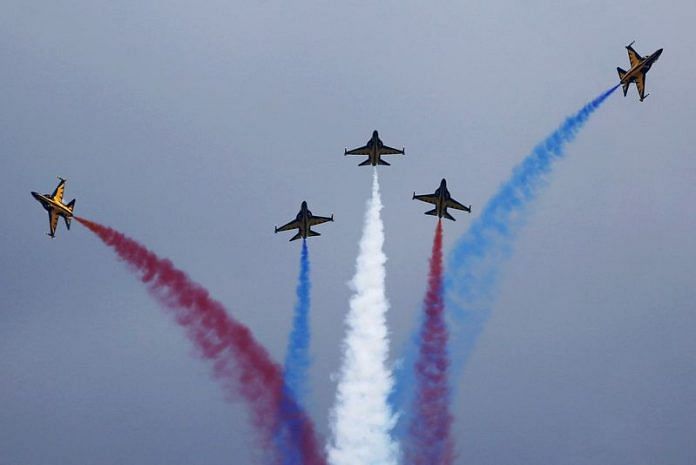By Lisa Barrington and Tim Hepher
SINGAPORE (Reuters) – Singapore will play host to Asia’s biggest air show next week for the first time since the end of COVID border restrictions, with regional travel rebounding and the military side of the show bristling with defensive systems and nervous arms buyers.
An expected full return of civil demand in Asia is being tested by an industry-wide supply crunch and macroeconomic headwinds, however – especially in the world’s second-largest aviation market, China – while geopolitical tensions have put weapons in the spotlight.
“Supply chain issues are limiting the ability of many airlines to upgrade their fleets and service their aircraft,” said Association of Asia Pacific Airlines head Subhas Menon.
The biennial show will also feature the first trip outside Chinese territory for China’s first homegrown passenger jet, COMAC’s narrow-body C919.
With the dominant two planemakers, Airbus and Boeing, struggling to ramp up production and meet demand for new planes, and Boeing struggling with a string of crises, air show attendees will be watching how the Commercial Aircraft Corporation Of China (COMAC) positions itself as a viable alternative.
Many inside the industry caution that only four C919s are in service in China; the plane is only certified by Chinese regulators; and the C919 relies on international supply chains.
Nevertheless, China’s aviation authority has said it would promote the plane internationally this year and pursue European Union Aviation Safety Agency (EASA) certification.
“We have also seen a growing trend where clients are including the C919 option in their fleet evaluation,” said Adam Cowburn of Alton Aviation Consultancy.
COMAC will be one of two commercial planemakers flying their planes alongside Airbus. Boeing will not send a commercial aircraft to the show this year.
It is the first major international industry event since last month’s blowout of a door plug on a 737 MAX 9 pushed Boeing into its second safety crisis in five years and sent images of a fuselage with a gaping hole whizzing across the globe.
Analyst Sash Tusa of UK-based Agency Partners said that in the past, the industry rarely discussed aviation safety in public, on the assumption that any mention would undermine confidence.
“But this omerta no longer seems to apply,” he added in a note.
ENVIRONMENT AND DEFENCE
Singapore will invite industry delegates to discuss aviation’s environmental impact, and will reveal a plan for making Singapore’s aviation sector sustainable.
In November, the global aviation industry agreed to lower fuel carbon emissions 5% by 2030, towards a goal of “net zero” carbon emissions by 2050.
“For the industry to meet its Fly Net Zero ambitions by 2050, Asia will be a key driver given that it will continue to remain the largest aviation market,” Cowburn said.
A massive ramp-up in sustainable aviation fuel (SAF) production is the current hope for meeting these targets, but it costs three to five times more than traditional jet fuel and there are concerns about how to sustainably meet demand.
“That awareness of aviation’s climate impact has been rising and the questions about this industry’s licence to operate have been increasingly raised – without there being a credible path of tackling that problem,” said Sami Jauhiainen of refiner Neste, which started refining SAF in Singapore last year.
Singapore is not traditionally a major show for new plane orders but some business could coincide with the show.
Some new freighters are also in demand, delegates said.
Amid spiralling tensions over Taiwan, disputes over South China Sea sovereignty and a spike in North Korean missile tests, regional defence budgets are rising. Systems from small drones to complex sub-hunting aircraft will be on display.
The war in Ukraine, which has seen extensive use of high-end air defences, and repeated attacks on Red Sea shipping, may also spur interest in systems that can intercept missiles and drones, as well as intelligence, surveillance and reconnaissance (ISR) platforms used to keep tabs on adversaries. No Russian companies are listed among the exhibitors at the air show.
Six air forces will stage flying demonstrations, including the United States, India and Korea.
(Reporting by Lisa Barrington in Seoul and Tim Hepher in Paris; Additional reporting by Xinghui Kok in Singapore)
Disclaimer: This report is auto generated from the Reuters news service. ThePrint holds no responsibilty for its content.



